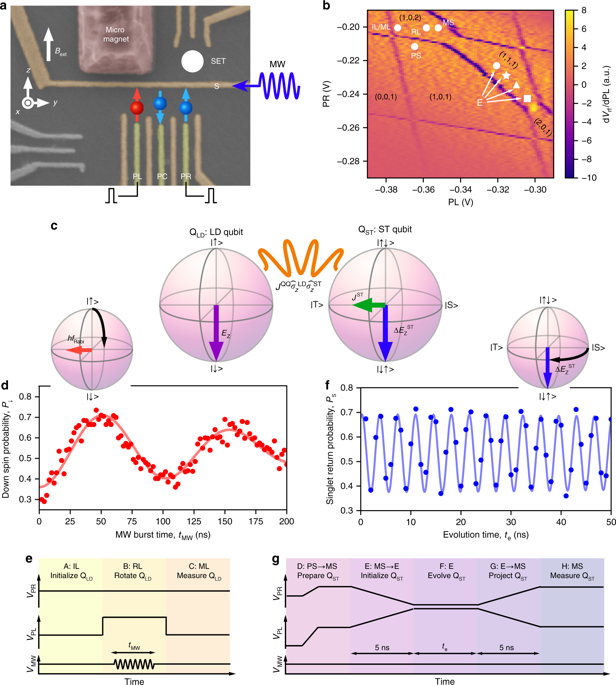RIKEN Center for Emergent Matter Science has constructed a hybrid quantum device made from two different types of qubits. They have created a device that can be quickly initialized and read out, and that simultaneously maintains high control fidelity.
They combined single-spin qubit called a Loss-DiVincenzo qubit and a singlet-triplet qubit.
The Loss-DiVincenzo qubit has very high control fidelity—meaning that it is in a clear state, making it ideal for calculations, and has a long decoherence time. It will stay in a given state for a relatively long time before losing its signal to the environment. Unfortunately, the downside to these qubits is that they cannot be quickly initialized into a state or read out.
The singlet-triplet qubit is quickly initialized and read out, but it quickly becomes decoherent. They combined the two types with a type of quantum gate known as a controlled phase gate, which allowed spin states to be entangled between the qubits in a time fast enough to maintain the coherence, allowing the state of the single-spin qubit to be read out by the fast singlet-triplet qubit measurement.
They have demonstrated that different types of quantum dots can be combined on a single device to overcome their respective limitations. This offers important insights that can contribute to the scalability of quantum computers.
They have created a fast quantum interface between a LD qubit and a ST qubit using a TQD. The CPHASE gate between these qubits is performed in 5.5 nanoseconds. This is much faster than its dephasing time of 211 nanoseconds and those ratio (~38) would be high enough to provide a high-fidelity CPHASE gate.
Optimizing the magnet design to enhance the field gradient would allow even faster gate time beyond a gigahertz.
Their approach will further push the demonstrated scalability of spin qubits in quantum dot arrays beyond the conventional framework based on a unique spin-qubit encoding.
Nature Communications – A fast quantum interface between different spin qubit encodings.
Abstract – A fast quantum interface between different spin qubit encodings
Single-spin qubits in semiconductor quantum dots hold promise for universal quantum computation with demonstrations of a high single-qubit gate fidelity above 99.9% and two-qubit gates in conjunction with a long coherence time. However, initialization and readout of a qubit is orders of magnitude slower than control, which is detrimental for implementing measurement-based protocols such as error-correcting codes. In contrast, a singlet-triplet qubit, encoded in a two-spin subspace, has the virtue of fast readout with high fidelity. Here, we present a hybrid system which benefits from the different advantages of these two distinct spin-qubit implementations. A quantum interface between the two codes is realized by electrically tunable inter-qubit exchange coupling. We demonstrate a controlled-phase gate that acts within 5.5 ns, much faster than the measured dephasing time of 211 ns. The presented hybrid architecture will be useful to settle remaining key problems with building scalable spin-based quantum computers.

Brian Wang is a Futurist Thought Leader and a popular Science blogger with 1 million readers per month. His blog Nextbigfuture.com is ranked #1 Science News Blog. It covers many disruptive technology and trends including Space, Robotics, Artificial Intelligence, Medicine, Anti-aging Biotechnology, and Nanotechnology.
Known for identifying cutting edge technologies, he is currently a Co-Founder of a startup and fundraiser for high potential early-stage companies. He is the Head of Research for Allocations for deep technology investments and an Angel Investor at Space Angels.
A frequent speaker at corporations, he has been a TEDx speaker, a Singularity University speaker and guest at numerous interviews for radio and podcasts. He is open to public speaking and advising engagements.

